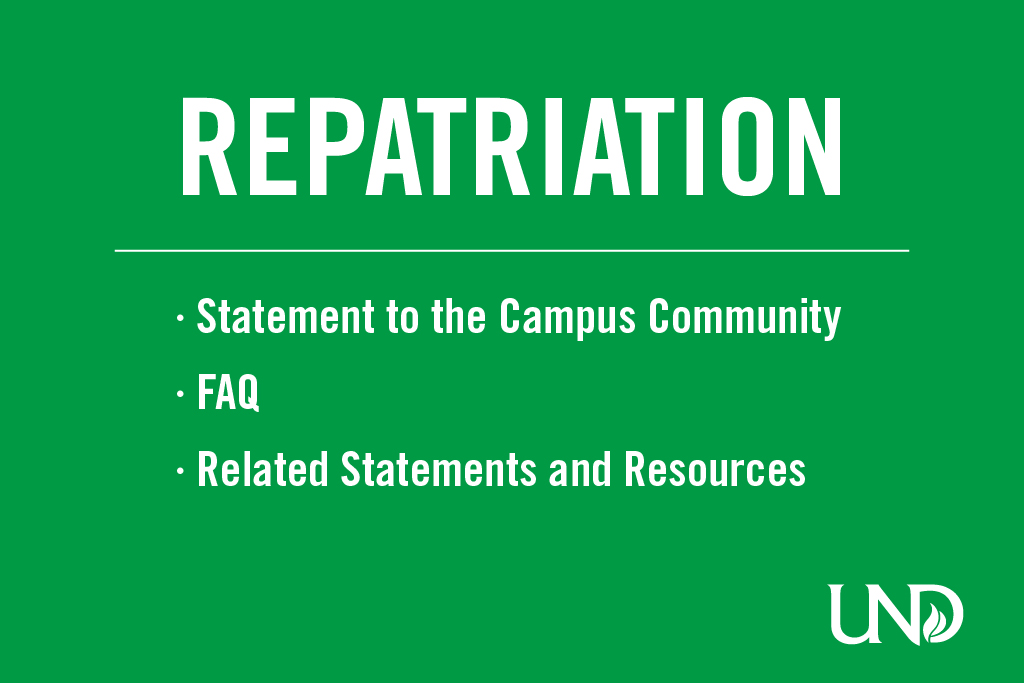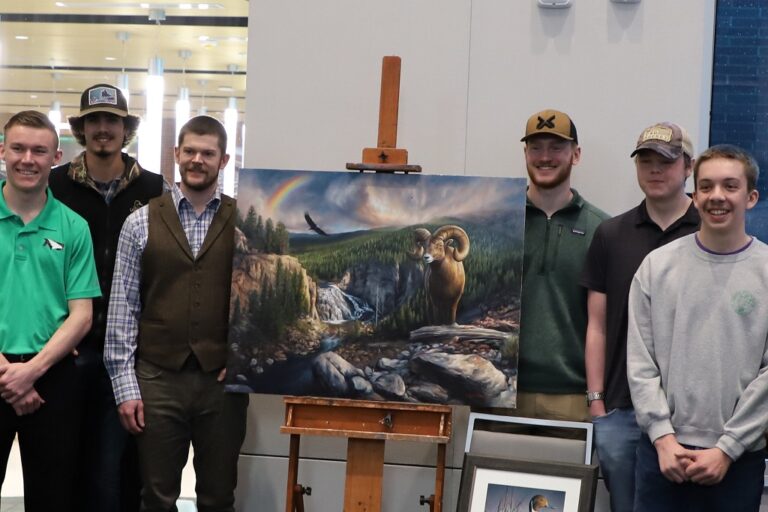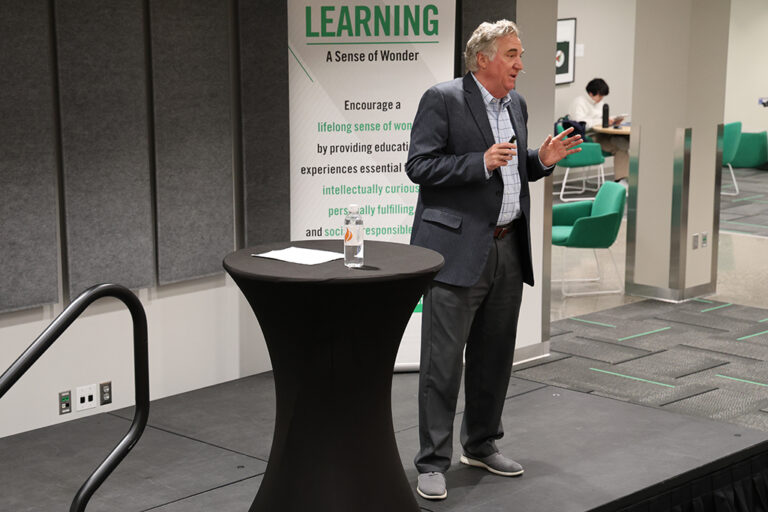Repatriation: UND’s response
Discovery of ancestors and artifacts prompts apology, outreach to tribal nations and other efforts to correct mistake

Editor’s note: On Wednesday, UND President Andy Armacost announced that earlier this year, a faculty-and-staff team had told him that they’d found on campus sacred objects and ancestral remains from Indigenous communities. Below is the statement in which President Armacost made this announcement; a list of answers to frequently asked questions about the subject; statements from North Dakota Gov. Doug Burgum, North Dakota Indian Affairs Commission Executive Director Nathan Davis and North Dakota University System Chancellor Mark Hagerott; and a list of mental health support services.
For more information, visit the Repatriation page on the website of the Office of the President.
Statement to the Campus Community
August 31, 2022
Dear Members of the UND Community,
I write this message with a heavy heart. In March, I was approached by a thoughtful team of faculty and staff members who raised a troubling issue. In the course of their work, they found on campus sacred objects from Indigenous communities. They also found human remains, which – in the tradition of tribal nations – are known as ancestors. These are believed to be partial skeletal remains from dozens of individuals.
First, I sincerely express my apologies and heartfelt regrets that UND has not already repatriated these ancestors and sacred objects as they should have been years ago. Second, I pledge my administration’s full support and commitment to the tribal nations impacted by this mistake. Our primary goal now is to work diligently until all ancestors and sacred objects are returned home, regardless of how long it takes.
Upon learning of this discovery, we reached out immediately to representatives from a half-dozen tribal nations. That number has now grown to thirteen and will continue to expand. We have been collaborating with them and seeking their advice for more than four months to make certain this work is done correctly, and this will continue until completion.
When the federal law known as the Native American Graves Protection and Repatriation Act (NAGPRA) was approved in 1990, the University had a responsibility to return ancestors and sacred objects to their tribal lands. Although this effort inexplicably fell short at UND, we are fully committed to righting this wrong. On campus, we have formed a NAGPRA Compliance Committee to work with tribal representatives in guiding our repatriation efforts, explaining cultural protocols, and assisting us in meeting the requirements of state and federal laws.
To conduct this process in a dignified and respectful manner, UND made no public statements during the initial contact phase with tribal authorities and the appropriate state and federal agencies. This decision was made in accordance with the guidance and wishes provided by the tribal representatives. During the early stages of this process, we have observed Indigenous customs and traditions in the handling of the ancestors and sacred objects, to the very best of our abilities.
We have also worked with government agencies to make certain we comply with the law as we undertake the repatriation process. The tribal representatives are leading efforts in their communities to share information about the repatriation work at the appropriate times and locations.
Repatriation will take time and hard work, perhaps several years. UND will hire the appropriate cultural resource consultants to help with this process. The remaining collection at UND is significant, with dozens of ancestors and several hundred containers of objects taken from Indigenous land and communities, requiring painstaking labor for identification and placement.
Coming on the heels of other recent revelations about historic wrongs inflicted on Indigenous people in the United States and Canada, members of our tribal communities in the region will undoubtedly be deeply affected by this news from UND. While I cannot take away their pain, I can apologize on behalf of UND for our mistakes. The tribal communities have my assurance that as a University, we are strongly committed to repatriation.
For those who are impacted by this news, we have resources on campus to support you. Professor Doug McDonald runs our Indians into Psychology Doctoral Education (INPSYDE) program, and he and his team are available with counseling services in support of Native American students, faculty, and staff. They can be reached at 701.777.4495 or 4497. The University Counseling Center also provides great support to students, and you can reach them at 701.777.2127.
Our UND land acknowledgement statement is a symbol of how seriously we – the University community – take issues impacting the Indigenous tribes of the region who call this land their home. Yet, the work of repatriation goes beyond an acknowledgment of the land and requires a true commitment to the Indigenous people who inhabit the land and to their ancestors. I pledge to see this through until all ancestors and sacred artifacts are brought home. As our repatriation efforts proceed, we will work with all involved to share timely information.
Andrew P. Armacost
President
University of North Dakota
Related statements
Gov. Doug Burgum:
We are heartbroken by the deeply insensitive treatment of these indigenous ancestral remains and artifacts and extend our deepest apologies to the sovereign tribal nations in North Dakota and beyond. This dark chapter, while extremely hurtful, also presents an opportunity to enhance our understanding and respect for indigenous cultures and to become a model for the nation by conducting this process with the utmost deference to the wishes, customs and traditions of tribal nations. We appreciate the deeply thoughtful, respectful approach being taken by UND and President Armacost, including their decision to reach out immediately to tribal representatives. We pledge to work with our tribal partners with understanding and mutual respect and assist wherever possible as UND and the North Dakota University System move toward ensured compliance with the Native American Graves Protection and Repatriation Act (NAGPRA).”
Nathan Davis, executive director, North Dakota Indian Affairs Commission:
As terrible as this news has been, and as insensitive and inexcusable the treatment of our ancestors has been historically in the name of science, I would like to commend and thank President Armacost and his team, including Native American faculty and staff, who have been leading these efforts. Sometimes as a leader the best thing that you can do is listen to those around you. The efforts to ensure that our people were not an afterthought is something that spoke volumes to me. While there is no way we can ever forget what has happened to our ancestors, we can honor them by making sure they return home to rest. We have a unique opportunity to honor them by changing the way that repatriation is done, as we all know that this work sadly isn’t over.
Mark Hagerott, chancellor, North Dakota University System:
We fully support the University of North Dakota’s repatriation efforts and stand with them as they proceed to rightfully return ancestors and sacred objects to their tribal lands. The institution’s thoughtful and respectful approach will ensure that the artifacts are handled appropriately and with the ancestral reverence that is deserved. Moreover, we are committed to Indigenous communities on all our campuses. Working through our campus presidents, we will coordinate a systemwide review of policies related to the respect and inclusion of our Indigenous population and ensure we are compliant with the Native American Graves Protection and Repatriation Act (NAGPRA).
Frequently asked questions:
What does repatriation mean? How is it carried out?
Repatriation is the process used to return human remains – referred to in many Indigenous traditions as ancestors – funerary objects, sacred objects or objects of cultural patrimony to the tribal nations from which they originated. The process is governed by the federal Native American Graves Protection and Repatriation Act (NAGPRA), which was enacted in 1990.
The process requires federal agencies and institutions that receive federal funds, such as museums, universities and state agencies, to transfer human remains and cultural items to the relevant tribe.
The University is working with tribal representatives, the appropriate federal agencies, and the North Dakota State Historical Society to resolve this as quickly as possible. The University’s leadership is strongly committed to completing the repatriation process for the return of the ancestors and artifacts to their rightful tribal locations. This repatriation process could take two or three years or perhaps longer.
What types of items are involved? Where are they now?
Ancestors and cultural items are still in the process of being identified. They include the partial skeletal remains of dozens of ancestors. Other items include ceremonial pipes, drums, textiles, regalia, pottery, tools and other items related to village life.
Ancestors and artifacts were stored at various locations on the UND campus. They are being stored in more than 200 boxes in a secure location on UND’s campus. The exact number of ancestors is unknown but is thought to be in the dozens. UND will hire a cultural resources manager with a Native American-owned business to assist in the process and follow regulations for repatriation.
One challenge the University faces is obtaining a complete inventory, as required by NAGPRA. Many items discovered have been moved to a secure location on the UND campus where tribal representatives will work with other trained professionals to identify the ancestors and artifacts for proper repatriation.
What are the government agencies with which UND is working?
UND is in contact with state and federal officials such as the U.S. Army Corps of Engineers, state archaeologists and directors of state historical societies. The University’s intent is to comply with NAGPRA while being sensitive to the tribal communities and the wishes expressed by their leaders. UND will continue working directly with the multiple tribes that attach religious and cultural significance to the ancestors and objects being repatriated, building relationships and a sense of trust.
When did UND administrators learn that there were cultural items, including human remains, that were required to be returned to Tribal Nations?
Although UND began work in January to make certain the University didn’t possess any items required for return to the tribes under NAGPRA, the process accelerated in February when a search for a missing sacred pipe was launched. This incident led to the discovery of ancestors and other artifacts stored in different locations on campus. Until then, UND was not aware it had ancestors in its possession.
In March 2022, UND President Andrew Armacost was informed that human remains were discovered in a building on campus. A search for other ancestors was initiated. Armacost and UND Provost Eric Link then authorized the search for a secure space to house the items discovered. Ceremonial smudging was done by UND faculty before other tribal representatives arrived in March. Smudging and prayers also were undertaken by tribal representatives and spiritual leaders in these spaces in August. Smudging is the ceremonial burning of plants or a mixture of plants for purification, usually applied to spaces or physical bodies.
Armacost, a UND faculty member and a member of the UND Alumni Association & Foundation then made the initial contact with tribal representatives. The dialogue between the University and the tribes continues to this day.
What were these artifacts used for?
One use of these items was for the purpose of academic study in forensic anthropology and related fields. Scholars studied objects to learn more about the people from which they came.
When were ancestors and cultural artifacts brought to UND? Who brought them to UND?
The first instance of tribal artifacts being brought to UND goes back to the University’s inception. In a 1906 academic paper, Henry Montgomery, the first UND faculty member, wrote about “Remains of Prehistoric Man in the Dakotas.” After conducting excavations, Montgomery came into the possession of cultural items, as well as the remains of ancestors. It’s unclear where those items are located, or even if they remain on the campus.
The remains of additional ancestors were brought to UND by subsequent anthropological and archaeological digs in the 1960s, ’70s and ’80s. One item was donated to the University in 2007.
What is the cost of this repatriation effort? How long will it take?
At this time, the total cost of UND’s repatriation effort cannot be estimated. The University is currently working with consultants to determine the time and resources needed to meet NAGPRA regulations. The University is committed to taking the proper course of action to repatriate all ancestors and artifacts in its possession in a respectful and culturally appropriate manner.
Has UND violated the federal NAGPRA law?
UND is not facing legal action. The University is acting with the greatest sense of urgency to enable repatriation to move forward as quickly as possible, bringing in outside experts to assist in this effort.
The University is working with multiple tribes that attach religious and cultural significance to the area, the appropriate federal agencies, and the North Dakota State Historical Society, as well as the states of Minnesota, South Dakota and Montana, to resolve this process as quickly as possible. The University’s leadership remains committed to completing the repatriation process for the return of the ancestors and artifacts to their rightful tribal locations.
Between the time NAGPRA went into effect in 1990 and 2022, what happened at UND?
As UND goes through the steps toward NAGPRA compliance and gathers the necessary information and documentation to complete its inventory, it expects to find information to better answer this question. But the University also acknowledges that this might not be possible because some of those involved are no longer living, while others either don’t possess detailed information or are employed elsewhere. Completing this process will require a committed team that includes cultural resource management expertise, a supportive administration, time and dedicated financial resources to assure NAGPRA compliance.
Were past presidents aware of the presence of ancestors and other artifacts?
Speculating on what previous administrations knew and why certain actions were taken or not taken doesn’t advance the repatriation process. At this moment, UND is focused on correcting past missteps by engaging in the hard work necessary for repatriation to occur. The University is working with the tribes and the state and federal agencies involved as it moves forward to handle the matter in a dignified and respectful manner, as the tribes have requested.
How the situation began and how it evolved is complicated because it dates to 1883, the founding of the University, when the excavation of human remains and artifacts from Native American burial sites was common practice for early archaeologists. Decades have passed since these items arrived, making it difficult to trace how they came to be in the University’s possession.
Will UND provide Native Americans with free tuition as a form of reparations?
This is a decision UND cannot make on its own. It must be approved by the North Dakota University System in conjunction with the North Dakota Legislature. Currently, UND offers scholarships for Native American residents, as approved by the state Legislature.
Will the public be informed of how the repatriation process is proceeding?
As the repatriation process continues, UND will share updated information regularly on its repatriation website and with tribal officials. It also will hold meetings with the campus Indigenous community to keep its members informed. The University recognizes the seriousness of what has occurred and is thoroughly committed to compassionately addressing the concerns of Indigenous people affected on our campus and throughout the region.
Is UND working with the NAGPRA program?
UND is working with tribal representatives to create an inventory of sacred items and ancestors on its campus. Once this inventory is complete, members of the NAGPRA program will become involved. Whenever ancestors, artifacts or other items from an archaeological site are found on campus, the proper state archaeologist for the item’s original location will be contacted. Site reports will be used to determine if the site is on federal land. The archaeologist or cultural resource manager for the federal agency of the correct district office then will be contacted.
Mental Health Support
Faculty, staff and students wanting mental health support relating to UND’s Indigenous repatriation are encouraged to seek support from the following resources.
UND Counseling Center
McCannel Hall, Room 200
2891 Second Ave N Stop 9042
Grand Forks, ND 58202-9042
P 701.777.2127
UND Northern Prairie Community Clinic
Columbia Hall, Room 1300
501 N Columbia Rd Stop 7132
Grand Forks, ND 58202
P 701.777.3745
Northeast Human Services Center (not affiliated with UND)
151 S Fourth St, Suite 401
Grand Forks, ND 58201-4735
P 701.795.3000
24-hour Behavioral Health Crisis Help
Call 211 for immediate help 24 hours a day, seven days a week, including weekends and holidays.
INPSYDE
The UND Indians into Psychology (INPSYDE) program will have Native psychologists and doctoral students available for informal support.
Dr. Justin McDonald
P 218.779.0494
justin.mcdonald@UND.edu
Additionally, someone from INPSYDE will be available at:
UND American Indian Center
315 Princeton St
9 a.m. Wednesday, Aug. 31, through noon Friday, Sept. 2, if you need to talk to someone.
Crisis Text Line
Text NATIVE to 741741 to reach a culturally aware trained counselor.
988 Suicide & Crisis Lifeline
If you or someone you know is struggling or in crisis, help is available. Call or text 988 or chat 988lifeline.org.


